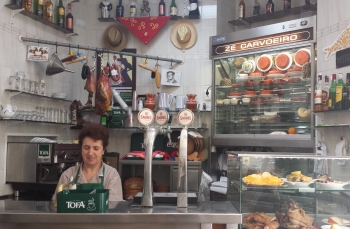How to identify an authentic Portuguese Tasca

In Portugal, there are two types of establishments that are more than just places to eat. They are places to meet friends and neighbors, to socialize, to gossip, to analyze last night’s football match, and yes, in good Portuguese fashion, to complain about the weather and the state of the country’s politics. One is the pastelaria (pastry shop), and the other is the mighty tasca.
What started out being a place where workers could warm up their own food, in exchange for buying wine and coffee (they were eager adopters of the Italian espresso machines, in the early 20th Century), developed into a temple of affordable and hearty food, with a homely ambiance to match its tasty eats.
Recently, the allure of the tasca brought many opportunists to the scene, keen to capitalize on the quaint charm of this historical institution. But fear not! With our help, you’ll quickly be able to tell the real from the fake, and sink your teeth into a veritable bastion of Portuguese food culture.
1 – Nothing costs more than 10 Euros
If there is a defining feature of the tasca is that it is affordable. After all, for more than a century it has been serving working class people, who can’t afford to eat regularly in restaurants. So, even if the food is good and has a homely style, if the prices don’t reflect it, give it a pass.
2 – The portions are generous
When you order at a tasca, you shouldn’t expect fancy plating, or extravagant preparations. What you should expect is a copious amount of food, served in a platter or a pot (like in the case of Portuguese soupy rice dishes). And if you need extra rice or potatoes, the waiter should oblige. After all, if you don’t leave a tasca with a full belly, you haven’t been to a real tasca.
3 – The staff is… charismatic!
Speaking of waiters: in the tasca there are usually two types of waiters/bartenders, who many times are the owners themselves. The first is the affable one: always ready to hit you with a joke (usually somewhat inappropriate), encouraging you to eat and drink more, tempting you with a dessert or a homemade liqueur. Bonus points if they happen to sport a moustache and/or a big belly.
The second kind of waiter is the grumpy one: he usually leads the chorus of complaints about the weather/traffic/politicians that characterizes the interactions at the tasca. Everything is a chore to him. He does not care about you, and yet you will feel an irresistible impulse to win him over. Because if you get a smile out of him, you’re a pro at the tasca game.
4 – There’s always colorful characters around
The staff are not the only characters you’ll meet at the tasca. It is a place of socializing, especially for men, so it’s rich in local personalities. The construction workers downing minis (small 200ml bottles of beer) at 9am. The policemen on duty, drinking coffee. The football aficionados, in R-rated discussions about the referee from the previous day’s match. Every good tasca must come with its own ecosystem, and the more you go, the more you’ll get to know it. Until maybe, one day, you become part of it too.
5 – There’s always paper towels
The paper towel is a symbol of the triumph of common sense over beauty. The paper towel is the most visible marker of a tasca, and an absolutely essential. Many times it is accompanied by an aesthetically challenged stainless steel bar, a television set prominently placed in a corner, and assorted decorations of dubious origins. The humble paper towel also can serve another noble purpose: announcing the daily specials, always handwritten, next to the front door.
6 – There’s football memorabilia on the walls
Football and tascas share a symbiotic relationship. Football matches bring customers, and tascas honor football by displaying the memorabilia of one or more football teams. If the owner of the tasca is a particularly fervent supporter of a team, he will display only his team’s souvenirs. However, if he is business savvy, all main Portuguese teams will have a place on his walls, along with (obviously) the national team.
7 – There are petiscos, not tapas
If you see the word tapas written anywhere, run. In Portugal, the snacky delights that go so well with a glass of red or a cold mini are called petiscos. And the more challenging the petisco, the more authentic the tasca. If you find pig’s ear salad, or fish eggs salad, you’re onto a winner.
8 – There Is Cozido à Portuguesa at least once a week
Speaking of challenging dishes, the Cozido à Portuguesa, the nemesis of any vegetarian, is basically a one pot wonder, where a multitude of vegetables (potato, cabbage, carrot, turnip, beans, etc) are boiled with an even more astounding variety of cuts of meat (which can go from chicken to pig’s trotter) as well as an array of traditional cured sausages (like chouriço, farinheira or morcela). It is sided by rice (because you can never have too many carbs) and it is a veritable bomb, that will leave you ready for a nap.
A true tasca will provide this true national dish at least once a week, usually at a specific day of the week. For some reason, Wednesdays seem to be a day many tascas have agreed upon.
9 – There’s always Doce da Casa
When it comes to desserts, consistency is the name of the game in the tasca world. One should always expect a few standard desserts. Chocolate Mousse (which should be homemade), Molotov (a gargantuan slice of fluffy egg whites, baked with a strong caramel), Pudim de Ovos (which is an egg flan), and the omnipresent Doce da Casa (house dessert).
You would think that each tasca would have a particular Doce da Casa, given its name. But actually, it’s just a combination of store-bought vanilla pudding, covered with a biscuit dipped in coffee, and topped with whipped cream. It’s no one’s favorite, yet it should always be present.
10 – The piri-piri sauce is homemade
There’s no subtlety in a tasca, and the spicy piri-piri sauce should match it: strong, homemade and no-frills. And if it doesn’t make you sweat a bit, it’s not done right. Also, you’re allowed to put it on anything, whether it is seafood rice, a pork sandwich, or even a kale soup. Piri-piri is for everyone and everything.
True tascas can be daunting for the uninitiated. There are dishes that you’re not familiar with. There’s noise, a little bit of chaos, maybe a few looks from the regulars. But if you are brave and just take the leap, you will find they truly are a treasure to be explored. And with our tips, you’ll be able to tell the real from the fake. You might even become another tasca connoisseur, and a keeper of secrets from the most Portuguese of all Portuguese establishments. Viva a tasca!
Feed your curiosity on Portuguese food culture:
How to identify the perfect Portuguese custard tart
The national dish of Portugal (it’s not codfish…)
Real people, real food. Come with us to where the locals go!
Join us in our natively curated food & cultural experiences.
Follow us for more at Instagram, Twitter and Youtube
